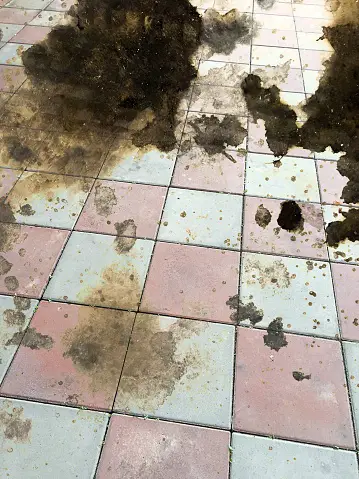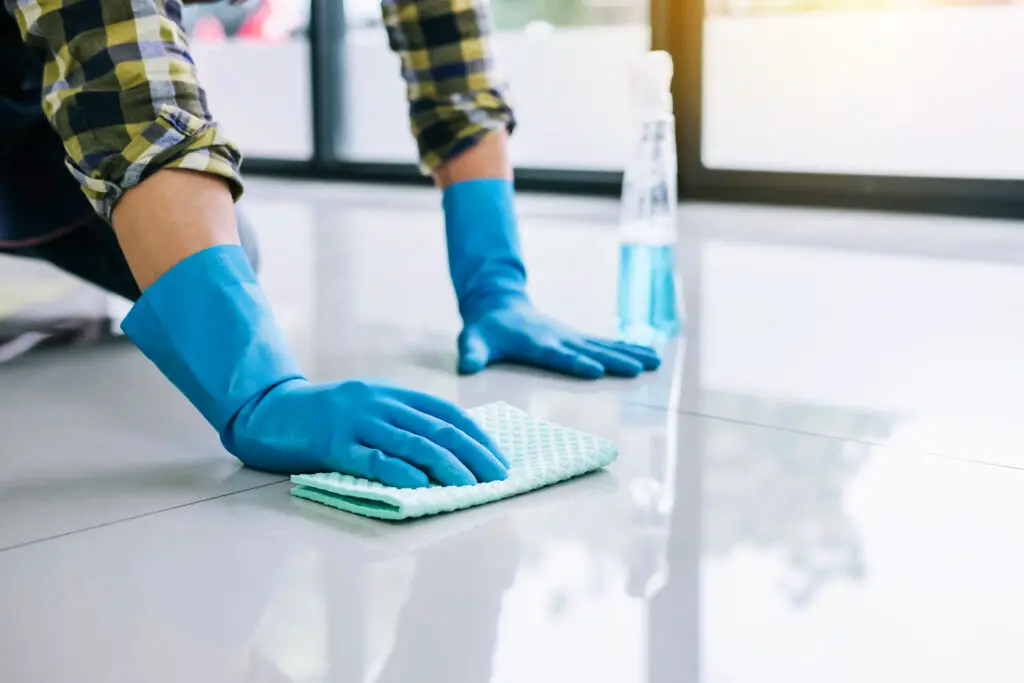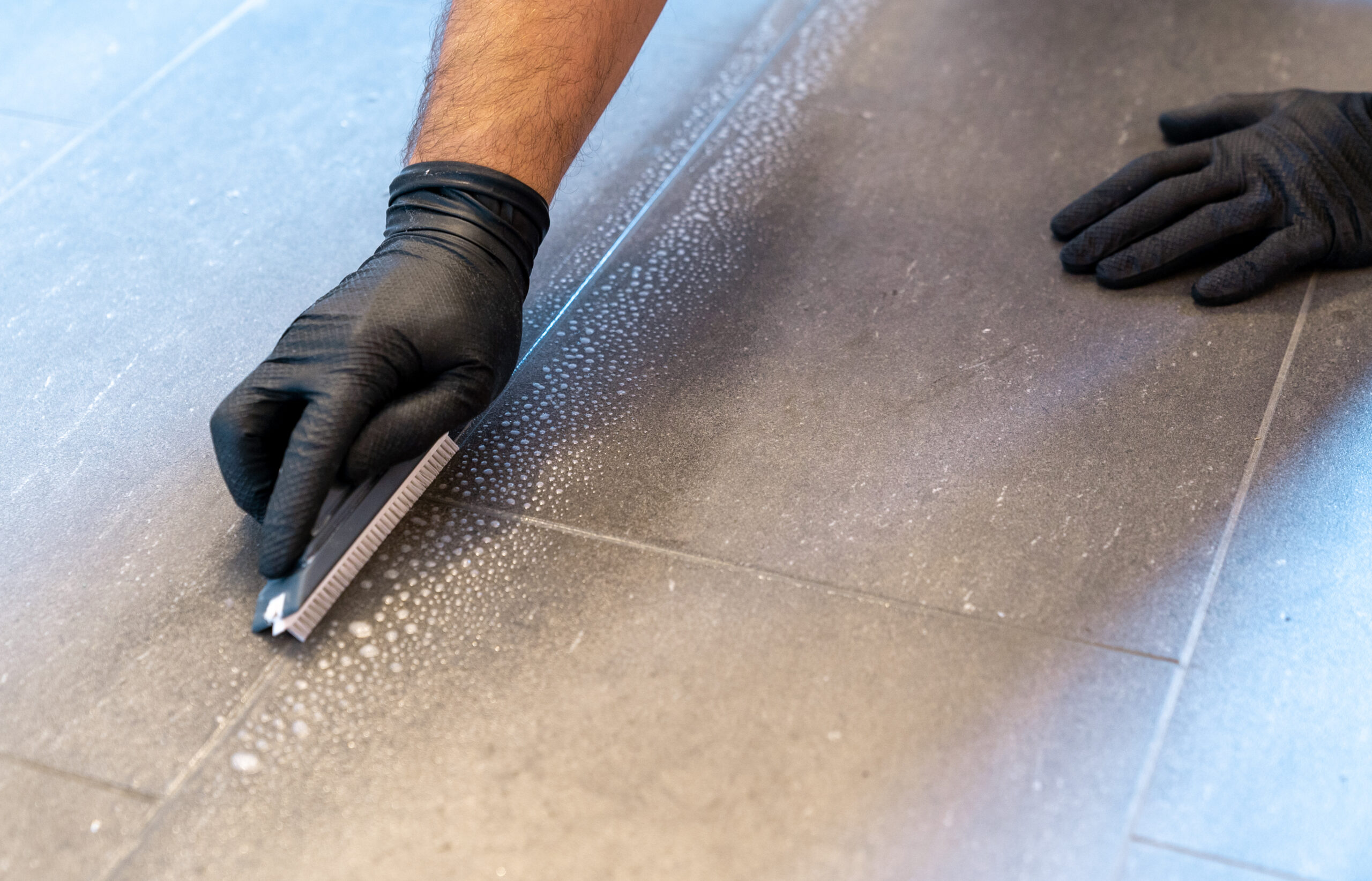If you have oil stains on your tile floor, it’s important to take the necessary precautions and steps to clean them up. The most common method of dealing with an oil spill is often to use a combination of detergent, water, and vinegar. In this article, we will discuss how to safely clean oil off a tile floor.
Oil spills on tile floors are a common household issue. They can occur due to various reasons like accidental spillages while cooking, oil-based products used for cleaning, or even mechanical leaks. These spills not only mar the aesthetic appeal of your floors with unsightly stains but can also make the surface slippery, posing a potential hazard.
If left untreated, oil can seep into the pores of the tiles, making them harder to clean over time. Therefore, it’s essential to tackle oil spills promptly and effectively.
Importance of Quick and Efficient Cleaning
The necessity for swift and efficient cleaning of oil spills on tile floors cannot be overstated. First and foremost, quick response prevents the oil from penetrating deeper into the tile surface, thereby reducing the chance of persistent stains.
Additionally, swift cleanup minimizes the risk of slipping and injuring oneself on the oily surface, thereby ensuring the safety of household members.
Efficient cleaning, on the other hand, guarantees that no oil residue is left on the floor, preserving the tiles’ aesthetic appeal and preventing them from becoming a dirt magnet.
Maintaining the hygiene and appearance of your tiles can also help prolong their life and save on potential future restoration costs. Therefore, the importance of quick and efficient cleaning is significant for both safety and aesthetic reasons.
Materials Needed
The materials necessary for cleaning oil off tile floors include:
- A bucket filled with warm water and a mild detergent solution.
- A mop or cloth that won’t damage the tiles.
- A sponge, scouring pad, or steel wool (if needed).
- An absorbent material such as sawdust, kitty litter, baking soda, or paper towels.
- A vacuum cleaner (optional).
Preparation
Before starting the cleaning process, it’s crucial to safeguard the area and prepare it to deal with the oil spill. Firstly, mark off the affected area to prevent people from accidentally stepping on the oily tiles and slipping. You can use warning signs or barriers for this purpose.
Next, begin by removing any loose dirt or debris from the area around the oil spill. This can be achieved with a broom or a vacuum cleaner. This step is necessary to prevent the dirt from getting mixed with the oil, complicating the cleaning process.
If the oil spill is fresh and hasn’t penetrated the tiles yet, try absorbing as much oil as possible using an absorbent material. This could be sawdust, kitty litter, baking soda, or paper towels.
Sprinkle the absorbent onto the spill, let it sit for a few minutes to absorb the oil, and then carefully sweep or vacuum it up.
Remember to wear gloves to protect your hands during the cleaning process. Prolonged contact with certain cleaning agents may cause skin irritation. If you’re using a stronger cleaning solution or if the spill is extensive, consider wearing safety goggles to protect your eyes from potential splashes.
Step-by-Step Cleaning Process
1. Initial Oil Removal: Absorbing the Excess Oil

Once you’ve prepared the area, the first step in the actual cleaning process is to absorb the excess oil from your tile flooring. If the oil spill is fresh, this step can prevent deeper penetration of the oil into your tiles.
Start by generously sprinkling your chosen absorbent material (sawdust, kitty litter, baking soda, or paper towels) onto the spill.
The absorbent material should ideally cover the entire oil spill and even extend a bit beyond its edges. Let the absorbent sit on the spill for several minutes, or until it appears saturated with oil. This waiting time allows the absorbent to soak up as much oil as possible.
Once the absorbent has done its job, carefully sweep or vacuum it up without spreading the oil to unaffected areas. Be sure to dispose of the oil-soaked material properly, considering its hazardous waste.
Repeat this process as necessary until no more oil is being absorbed into the material. This initial step will make the subsequent cleaning much more effective.
2. Deep Cleaning: Applying a Cleaning Solution

After the initial excess oil has been absorbed, the next step in the cleaning process is deep cleaning with a suitable cleaning solution. This is essential to remove any residual oil that may have seeped into the tiles or grout lines.
Begin by preparing your cleaning solution. For oil spills, a mixture of warm water and dish soap works well. Dish soap is designed to cut through grease and oil, making it an effective cleaner for this purpose. Mix one part dish soap to ten parts warm water in a bucket.
Soak a clean, soft cloth or sponge in the solution and wring it out so that it’s damp but not dripping. Apply the damp cloth or sponge to the affected area, gently scrubbing in a circular motion. Pay special attention to the grout lines, as these areas can retain oil.
After scrubbing, rinse the area thoroughly with clean, warm water to remove any soapy residue. It’s crucial to remove all soap, as any remaining residue can attract dirt.
Finally, pat the area dry with a clean towel to avoid water spots or streaks. Repeat this process as necessary until the oil stain is completely gone.
3. Scrubbing: Using a Brush to Remove Stubborn Oil

In some cases, a cloth or sponge might not be sufficient to fully remove stubborn oil stains from your tile floor. This is where a brush comes in handy. Choose a soft-bristle brush to avoid scratching or damaging the tile surface.
Dip the brush into your cleaning solution and gently scrub the stained area in a circular motion. A toothbrush can be particularly effective for smaller, more stubborn stains or for reaching into tight grout lines.
Be careful not to scrub too hard, as this could cause damage to the tile or grout. After scrubbing, rinse the area thoroughly with clean, warm water to remove any soap or loosened oil residue. Dry the area thoroughly with a clean towel.
This process may need to be repeated several times for particularly stubborn stains.
4. Rinsing: Washing Away the Cleaning Solution
Once you’ve thoroughly scrubbed the oil-stained area, the next critical step is rinsing. This helps to wash away the cleaning solution and any loosened oil residue. For this, you should use warm, clean water. It’s best to use a clean, damp cloth or sponge for this purpose.
Gently wipe over the scrubbed area, ensuring you cover all the spots where the cleaning solution was applied. It’s essential to change the water frequently while rinsing to avoid reapplying the oil or soap back onto the tiles.
Remember, the goal is to get rid of all the cleaning solution and the oil residue, so rinse as many times as necessary until the water runs clear.
Once done, dry the area with a clean towel to prevent water spots and streaks. Re-examine the area to ensure no oil stains are left. If any stains persist, you may need to repeat the entire cleaning process.
5. Drying: Ensuring the Tile is Completely Dry to Avoid Slips
After the rinsing process, it’s crucial to make sure the tile floor is thoroughly dry. A wet or damp tile floor can become a slipping hazard and may also foster the growth of mold or mildew. To effectively dry your tile floor, start by using a clean, dry towel to wipe down the area.
Be sure to reach into the grout lines where water can often hide. For an extra measure of safety, consider using a hairdryer or fan to expedite the drying process, focusing particularly on the grout lines.
It’s essential to ensure that all moisture has been removed before walking on the tiles to prevent slips and falls. If you notice any damp spots, repeat the drying process until completely dry. Remember, safety first – a clean floor should also be a safe floor.
Related Topics:
Precautions
Safety Measures While Cleaning
While cleaning oil off your tile floor, always prioritize safety. Begin by wearing suitable protective gear, including rubber gloves to protect your hands from harsh cleaning solutions and non-slip shoes to prevent slipping on the oily or wet floor.
Also, ensure the room is well-ventilated when using cleaning solutions to avoid inhaling potentially harmful fumes.
It’s advisable to keep any children or pets away from the area until the cleaning and drying process is entirely complete to prevent accidental slips or contact with the cleaning products.
Finally, if you’re using a commercial cleaning solution, always follow the instructions on the label, and avoid mixing different cleaners, as this can result in harmful chemical reactions. Remember, maintaining safety while cleaning is as important as the cleaning process itself.
Preventing Future Oil Spills
To mitigate future oil spills on your tile floor, several proactive steps can be taken. First, consider using floor mats or rugs in areas prone to spills, such as near the cooking range or sink in the kitchen, or the entrance of the garage.
These can absorb small spills, making clean-ups quicker and easier. Additionally, regular maintenance of objects and appliances that contain or use oil can also help prevent unexpected leaks. This includes items like your car, cooking appliances, or mechanical equipment.
Promptly fixing any identified leaks can save you a big mess down the line.
Moreover, adopting careful handling procedures when using or transferring oil can also significantly reduce the risk of spills. Always ensure that lids or caps are securely fastened after use, and use a funnel or spout when pouring oil.
Lastly, educate everyone in the household about the importance of these measures. After all, prevention is better than cure, and in this case, it means less time cleaning up oil spills off your tile floor.
Related Topic: How To Cut Smartcore Tile Flooring? (Guide)
Conclusion
Cleaning up oil spills on tile floors can be a tricky, time-consuming task. However, with the right know-how and products, it doesn’t have to be overwhelming. By following the steps outlined above, you can effectively remove any spots or stains that may appear on your tile floor due to an unexpected oil spill.
Additionally, by taking proactive measures such as using rugs or mats in areas prone to spills, regular maintenance of machinery containing oil, and careful handling when transferring liquids, you can minimize the chances of future spills occurring.
With this knowledge in hand, cleaning up any oil-related messes on your tile floors should be a breeze!
Of course, it’s always best to clean up any spills as soon as possible. The longer the oil is left on the tile floor, the harder it will be to remove. With the right cleaning products and a bit of elbow grease, you can keep your tile floors looking like new!


1 thought on “How To Clean Oil Off Tile Floor? 5 Easy Steps”